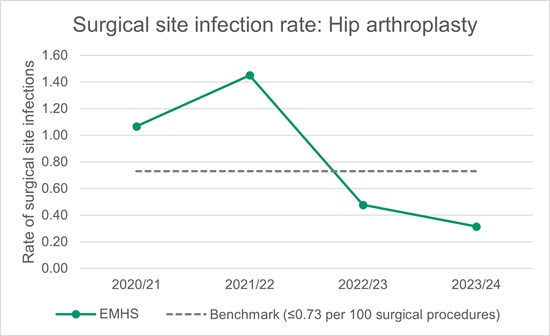Surgical Site Infections
Surgical site infections (SSI) is one of the most common complications associated with surgery and every patient who undergoes surgery is at risk of acquiring an infection. A patient who develops a SSI will often have a longer hospital stay or be readmitted, require antibiotics to treat the infection, and sometimes require further surgery.
A surveillance program that includes monitoring of SSIs can have an immediate and prolonged impact on reducing infections. WA hospitals share this information with their clinicians and hospital executives and use this information to support improved compliance with infection prevention strategies and to initiate practices to further improve patient outcomes.
Measuring surgical site infections for selected surgical procedures
The rate of surgical site infection is measured by counting the number of patients with an infection from the surgical procedure during a set period and dividing by the total number of patients who have undergone the surgical procedure during the set period.
The two selected surgical procedures that are measured are:
- Primary Hip Arthroplasty
- Primary Knee Arthroplasty
Primary hip arthroplasty
How do we measure up
The graph below shows the surgical site infection rate for the primary hip arthroplasty procedure for the EMHS hospitals:
- Armadale Health Service
- Royal Perth Hospital
- St John of God Midland Public Hospital

What the figures mean
The graph shows the overall rate of surgical site infection for primary hip arthroplasty across EMHS public hospitals by financial year.
The benchmark is less than or equal to 0.73 infections per 100 surgical procedures. A rate lower than the benchmark is desirable.
The rate of surgical site infection has been above benchmark for two years out of the past four years. EMHS continues to monitor, review and identify strategies towards greater prevention of infection.
Primary knee arthroplasty
How do we measure up
The graph below shows the surgical site infection rate for the primary knee arthroplasty procedure for the EMHS hospitals:
- Armadale Health Service
- Royal Perth Hospital
- St John of God Midland Public Hospital

What the figures mean
The graph shows the overall rate of surgical site infection for primary knee arthroplasty across EMHS public hospitals by financial year. The benchmark is less than or equal to 0.44 infections per 100 surgical procedures. A rate lower than the benchmark is desirable. The rate of surgical site infection has been below benchmark for the past four years. EMHS continues to monitor, review and identify strategies towards greater prevention of infection.

